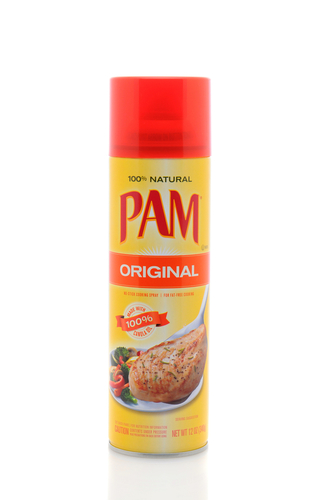Short answer
The idea behind cooking spray is brilliant, but one quick look at the ingredient list will have you questioning the product. PAM contains harmful ingredients, some of which contain GMOs, and can lead to unwanted side effects. Switching to a healthier alternative is the best option.
Recommended Alternative
Long answer
Cooking sprays, such as Pam seem to provide the miracle of non-stick cooking, easy frying pan clean up, and practically no calories. Pam is virtually fat-free and according to its label, it’s also sodium and cholesterol free. In addition, it’s available in several flavors to enhance cooking. However, a further look at their ingredients reveals little to be excited about.
The main ingredient in Pam cooking spray is canola oil, known to be low in saturated fat, high in polyunsaturated fat and monounsaturated fatty acids. Canola oil is produced from the rapeseed plant which has been genetically modified to be resistant to pests, herbicides, and weather. The safety of genetically modified foods has come under fire due to adverse side effects, and most health-conscious consumers prefer to avoid (Genetically Modified Organisms) GMOs when choosing food for their family. GMOs are notorious for causing a multitude of cancers and other life-threatening diseases, in order to for the producer to make products larger, faster, and more appealing.
Soy lecithin is another ingredient in Pam cooking spray. Soy is another genetically modified plant; 91% of all soy products in the US are GMOs, according to the USDA. Lecithin is an emulsifier and helps hold the ingredients together. Derived from the soybean plant, soy lecithin is the part that’s left over following extraction of soybean oil. The Soy Info Center describes it as a brownish sludge which is then processed with hydrogen peroxide and finally extracted using acetone.
Pam cooking spray is produced by the food manufacturing giant, ConAgra, which has come under fire recently for using genetically modified foods in its “all natural” brands.
Of additional concern are the propellants used in spray cans. Cooking sprays typically contain hydrocarbons, highly flammable substances, which should not be used near an open flame. According to ConAgra, the specific hydrocarbons used in Pam cooking spray are food-grade, FDA approved, butane and propane. When sprayed, the propellants evaporate into the air, leaving only the oil in the pan. In addition, hydrocarbons are toxic to the environment and have been linked to the destruction of the earth’s natural protective ozone layer.
There are numerous reasons to avoid using Pam cooking spray, from the potential risks of consuming GMOs and toxic chemicals, to the negative impact on the environment. When you are ready to cook, pull out some good ‘ole fashion organic butter—when enjoyed in moderation, this is by far a healthier alternative. If you prefer the convenience of a spray, you can purchase a pump spray bottle and add your own organic olive oil.
Possible short-term side effects
- bloating
- diarrhea
- nausea
- facial swelling
Possible long-term side effects
- lung problems
- autoimmune disorders
- infertility
- damage to vital organs
- cancer
- new allergies
Ingredients to be aware of
- petroleum gas
- propane
- butane
- dimethyl silicone
- soy lecithin
- gmos

Benefits
- convenient
- zero-calorie
Healthier alternatives
Recommended (what is this?)
FLAIROSOL OLIVIA Sprayer
- Advanced spray technology
- Portion control feature
- Continuous mist output
- Trust by chefs
- Glass bottle construction
 Approved by
Approved by 















